SLVSCK4A September 2015 – May 2016 TPS61235P , TPS61236P
PRODUCTION DATA.
- 1 Features
- 2 Applications
- 3 Description
- 4 Revision History
- 5 Device Comparison Table
- 6 Pin Configuration and Functions
- 7 Specifications
-
8 Detailed Description
- 8.1 Overview
- 8.2 Functional Block Diagram
- 8.3
Feature Description
- 8.3.1 Boost Controller Operation
- 8.3.2 Soft Start
- 8.3.3 Enable and Disable
- 8.3.4 Constant Output Voltage and Constant Output Current Operations
- 8.3.5 Over Current Protection
- 8.3.6 Load Status Indication
- 8.3.7 Under voltage Lockout
- 8.3.8 Over Voltage Protection and Reverse Current Block
- 8.3.9 Short Circuit Protection
- 8.3.10 Thermal Shutdown
- 8.4 Device Functional Modes
-
9 Applications and Implementation
- 9.1 Application Information
- 9.2
Typical Applications
- 9.2.1
TPS61236P 3-V to 4.35-V Input, 5-V Output Voltage, 3-A Maximum Output Current
- 9.2.1.1 Design Requirements
- 9.2.1.2 Detailed Design Procedure
- 9.2.1.3 TPS61236P 5-V Output Application Curves
- 9.2.2 TPS61236P 2.3-V to 5-V Input, 5-V 2-A Output Converter
- 9.2.1
TPS61236P 3-V to 4.35-V Input, 5-V Output Voltage, 3-A Maximum Output Current
- 10Power Supply Recommendations
- 11Layout
- 12Device and Documentation Support
- 13Mechanical, Packaging, and Orderable Information
7 Specifications
7.1 Absolute Maximum Ratings
over operating free-air temperature range (unless otherwise noted)(1)| MIN | MAX | UNIT | ||
|---|---|---|---|---|
| Voltage(2) | VIN, EN, VOUT, CC, INACT, FB | –0.3 | 6 | V |
| SW | –0.3 | 7 | V | |
| Operating junction temperature, TJ | –40 | 150 | °C | |
| Storage temperature, Tstg | –65 | 150 | °C | |
(1) Stresses beyond those listed under absolute maximum ratings may cause permanent damage to the device. These are stress ratings only, and functional operation of the device at these or any other conditions beyond those indicated under recommended operating conditions is not implied. Exposure to absolute-maximum-rated conditions for extended periods my affect device reliability.
(2) All voltages are with respect to network ground terminal.
7.2 ESD Ratings
| VALUE | UNIT | |||
|---|---|---|---|---|
| V(ESD) | Electrostatic discharge | Human-body model (HBM), per ANSI/ESDA/JEDEC JS-001(1) | ±4000 | V |
| Charged-device model (CDM), per JEDEC specification JESD22-C101(2) | ±1500 | |||
(1) JEDEC document JEP155 states that 500-V HBM allows safe manufacturing with a standard ESD control process.
(2) JEDEC document JEP157 states that 250-V CDM allows safe manufacturing with a standard ESD control process.
7.3 Recommended Operating Conditions
| MIN | NOM | MAX | UNIT | |||
|---|---|---|---|---|---|---|
| VIN(1) | Supply voltage at VIN pin | 2.3 | VOUT – 0.6 | V | ||
| VOUT | Target output voltage (TPS61235P) | 5.1 | V | |||
| Target output voltage (TPS61236P) | 2.9 | 5.5 | V | |||
| L | Effective inductance | 0.7 | 1 | 1.3 | µH | |
| CI | Effective input capacitance(2) | 4.7 | 10 | µF | ||
| CO | Effective output capacitance(2) | 20 | µF | |||
| CRCC | Capacitor parallel with the RCC resistor connected at CC pin | 1 | 10 | nF | ||
| RINACT | INACT pin pull up resistance | 1 | MΩ | |||
| REN | EN pin pull down resistance | 1 | MΩ | |||
| TJ | Operating junction temperature | –40 | 125 | °C | ||
(1) The maximum input voltage should be 0.6-V lower than the output voltage in Constant Voltage operation for the TPS6123x to function correctly.
(2) Effective capacitance value. Ceramic capacitor’s derating effect under bias should be considered when selecting capacitors.
7.4 Thermal Information
| THERMAL METRIC(1) | TPS61235P | UNIT | |
|---|---|---|---|
| TPS61236P | |||
| RWL (VQFN) | |||
| 9 PINS | |||
| RθJA | Junction-to-ambient thermal resistance | 28.7 | °C/W |
| RθJC(top) | Junction-to-case(top) thermal resistance | 24.1 | °C/W |
| RθJB | Junction-to-board thermal resistance | 10.9 | °C/W |
| ψJT | Junction-to-top characterization parameter | 0.1 | °C/W |
| ψJB | Junction-to-board characterization parameter | 10.8 | °C/W |
| RθJC(bottom) | Junction-to-case(bottom) thermal resistance | 1.6 | °C/W |
(1) For more information about traditional and new thermal metrics, see the Semiconductor and IC Package Thermal Metrics application report.
7.5 Electrical Characteristics
TJ = –40°C to 125°C and VIN = 3.6 V. Typical values are at TJ = 25°C, unless otherwise noted.| PARAMETER | TEST CONDITIONS | MIN | TYP | MAX | UNIT | ||
|---|---|---|---|---|---|---|---|
| POWER SUPPLY | |||||||
| VIN | Input voltage | 2.3 | VOUT – 0.6 | V | |||
| VUVLO | Input under voltage lockout | VIN rising | 2.2 | 2.3 | V | ||
| Hysteresis | 125 | mV | |||||
| IQ | Quiescent current into VIN | IC enabled, No Load, No switching, VOUT = 5.1 V |
5 | 11 | µA | ||
| Quiescent current into VOUT | 5 | 30 | µA | ||||
| ISD | Shutdown current into VIN | IC disabled, TJ = –40°C to 85°C | 0.01 | 3 | µA | ||
| OUTPUT | |||||||
| VOUT | Output voltage range | TPS61236P | 2.9 | 5.5 | V | ||
| Output voltage | PWM mode, TPS61235P |
5.0 | 5.1 | 5.2 | V | ||
| PFM mode, TPS61235 |
5.2 | V | |||||
| VFB | Feedback voltage | PWM mode, TPS61236P |
1.219 | 1.244 | 1.269 | V | |
| PFM mode, TPS61236P |
1.256 | V | |||||
| VOVP | Output over voltage protection threshold | 5.60 | 5.80 | 5.93 | V | ||
| ILKG_FB | Leakage current into FB pin | TPS61235P, VFB = 5.1 V | 4000 | nA | |||
| TPS61236P, VFB = 1.244 V | 120 | nA | |||||
| ILKG_SW | Leakage current into SW pin | IC disabled, TJ = –40°C to 85°C, VSW = 5.1 V |
0.05 | 2 | µA | ||
| ILKG_VOUT | Leakage current into VOUT pin | IC disabled, TJ = –40°C to 85°C, VOUT = 5.1 V |
0.05 | 2 | µA | ||
| Line regulation | IOUT = 2A, VIN = 2.7 V to 4.5 V, VOUT = 5.1 V |
0.06 | %/V | ||||
| Load regulation | IOUT = 0.5 A to 3 A, VIN = 3.6 V, VOUT = 5.1 V |
0.06 | %/A | ||||
| POWER STAGE | |||||||
| RDS(on) | High side MOSFET on resistance | VOUT = 5.1 V | 14 | 30 | mΩ | ||
| Low side MOSFET on resistance | VOUT = 5.1 V | 14 | 30 | mΩ | |||
| fsw | Switching frequency | VOUT = 5.1 V, PWM mode | 750 | 1000 | 1250 | kHz | |
| Constant output current limit accuracy | RCC = 124 kΩ, TJ = 25°C |
–15% | 15% | ||||
| RCC = 61.9 kΩ, TJ = 25°C |
–10% | 10% | |||||
| RCC = 61.9 kΩ, TJ = –20°C to 125°C |
–15% | 15% | |||||
| ILIM | Switch valley current limit | TJ = –20°C to 100°C | 6.5 | 8 | 9.5 | A | |
| ILIM_pre | Precharge mode current limit | VOUT = 0 V, TJ = 0°C to 125°C |
0.05 | 0.25 | 0.8 | A | |
| VOUT = 2 V | 1.3 | A | |||||
| VOUT = 3 V | 1.7 | A | |||||
| IINACT_th | Inactive threshold | VOUT = 5.1 V | 50 | mA | |||
| tINACT_delay | Deglitch delay | VOUT = 5.1 V | 15 | ms | |||
| TSD | Thermal shutdown threshold | TJ rising | 140 | °C | |||
| Hysteresis | 15 | °C | |||||
| LOGIC INTERFACE | |||||||
| VEN_H | EN Logic high input voltage | 1.0 | V | ||||
| VEN_L | EN Logic low input voltage | 0.4 | V | ||||
| ILKG_EN | EN pin input leakage current | EN pin connected to GND or VIN | 0.01 | 0.3 | µA | ||
| VINACT | INACT pin output low level voltage | ISINK_INACT = 80 µA | 0.4 | V | |||
7.6 Typical Characteristics
VIN = 3.6 V, VOUT = 5.0 V, TJ = –40°C to 125 °C, unless otherwise noted.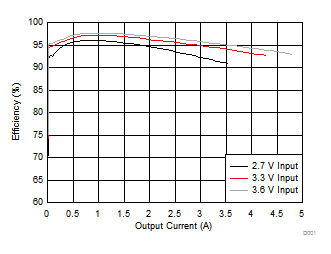
| VOUT = 4.5 V (TPS61236P), CC pin connected to GND | ||
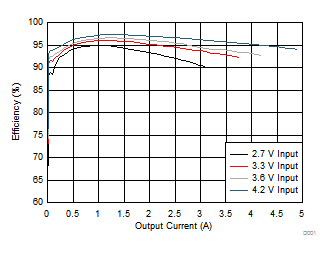
| VOUT = 5.5 V (TPS61236P), CC pin connected to GND | ||
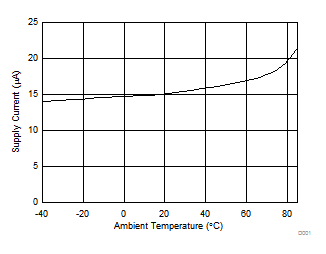
| VOUT = 5.1 V (TPS61235P), VIN = 3.6 V, No Load | ||
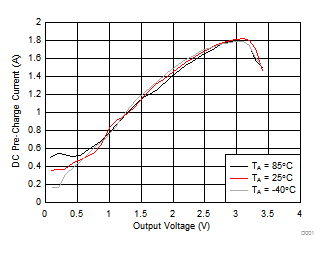
| 3.6-V Input |
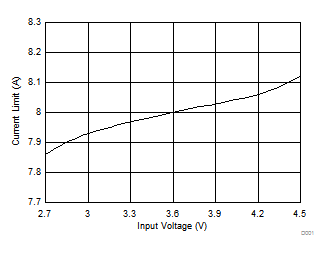
| TA = 25°C |
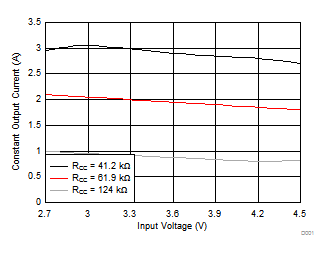
| VOUT = 5.1 V (TPS61235P), TA = 25°C | ||
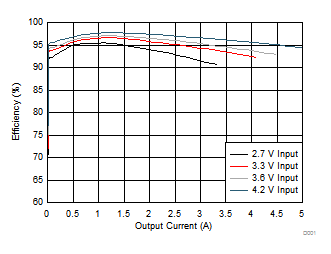
| VOUT = 5.1 V (TPS61235P), CC pin connected to GND | ||
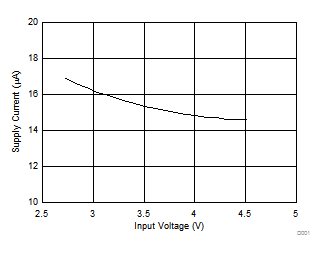
| VOUT = 5.1 V (TPS61235P), No Load, TA = 25°C | ||
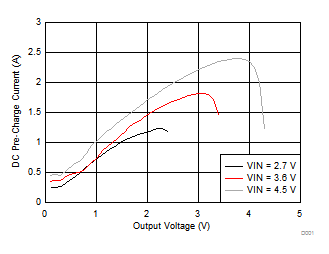
| TA = 25°C |
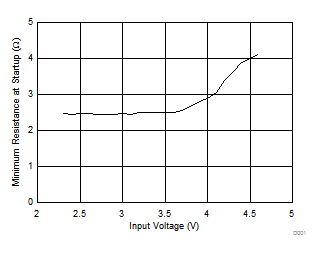
| VOUT = 5.1 V (TPS61235P), CC pin connected to GND, TA = 25°C |
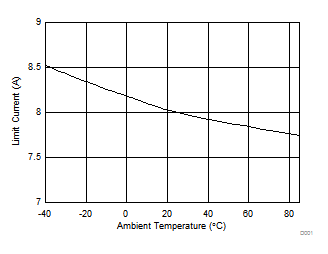
| VIN = 3.6 V |
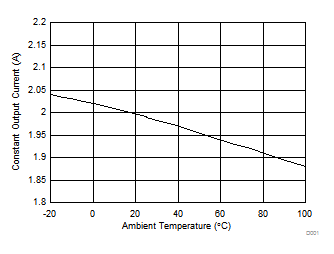
| VOUT = 5.1 V (TPS61235P), RCC = 61.9 kΩ (CC current set to 2 A) |